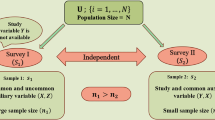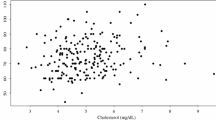Abstract
Coverage, i.e., the area covered by the target attribute in the study region, is a key parameter in many surveys. Coverage estimation is usually performed by adopting a replicated protocol based on line-intercept sampling coupled with a suitable linear homogeneous estimator. Since coverage is a parameter which may be interestingly represented as the integral of a suitable function, improved Monte Carlo strategies for implementing the replicated protocol are introduced in order to achieve estimators with small variance rates. In addition, new specific theoretical results on Monte Carlo integration methods are given to deal with the integrand functions arising in the special coverage estimation setting.
Similar content being viewed by others
References
Affleck DRL, Gregoire TG and Valentine HT (2005). Design unbiased estimation in line intersect sampling using segmented transects. Environ Ecol Stat 12: 139–154
Barabesi L (2003a). A Monte Carlo integration approach to Horvitz-Thompson estimation in replicated environmental designs. Metron LXI: 355–374
Barabesi L (2003). Sampling designs for monitoring ecological diversity. In: El-Sharaawi, A (eds) Environmetrics, Encyclopedia of Life Support Systems (EOLSS), developed under the auspices of the UNESCO, pp. Eolss Publishers, Oxford
Barabesi L and Fattorini L (1997). Line intercept sampling with finite populations: A stereological approach. Metron LV: 23–37
Barabesi L and Fattorini L (1998). The use of replicated plot, line and point sampling for estimating species abundancies and ecological diversity. Environ Ecol Stat 5: 353–370
Barabesi L and Marcheselli M (2003). A modified Monte Carlo integration. Int Math J 3: 555–565
Barabesi L and Marcheselli M (2005). Some large-sample results on a modified Monte Carlo integration method. J Stat Plan Inference 135: 420–432
Barabesi L and Pisani C (2002). Ranked set sampling for replicated sampling designs. Biometrics 58: 586–592
Barabesi L and Pisani C (2004). Steady-state ranked set sampling for replicated environmental sampling designs. Environmetrics 15: 45–56
Bonham CD (1989). Measurements for terrestrial vegetation. Wiley, New York
Bra’ezis H (1983). Analyse fonctionelle. Masson, Paris
Canfield RH (1941). Application of line intercept method in sampling range vegetation. J For 39: 388–394
Cruz-Orive LM (1993) Systematic sampling in stereology. In: Bulletin of the International Statistical Institute, Proceedings of 49th Session, Florence. 1993, 53:451–468
Evans M and Swartz T (2000). Approximating integrals via Monte Carlo and deterministic methods. Oxford University Press, Oxford
Garca’ıa-Fiñana M and Cruz-Orive LM (2000). Fractional trend of the variance in Cavalieri sampling. Image Anal Stereol 19: 71–79
Gregoire TG and Monchevich NS (1994). The reflection method of line intercept sampling to eliminate boundary bias. Environ Ecol Stat 1: 219–226
Gregoire TG and Valentine H (2003). Line intersect sampling: ell-shaped transect and multiple intersection. Environ Ecol Stat 10: 263–279
Haber S (1966). A modified Monte-Carlo quadrature. Math Comput 20: 361–368
Haber S (1967). A modified Monte-Carlo quadrature. II, Math Comput 21: 388–397
Husch B, Miller CI and Beers TW (1982). Forest mensuration. Wiley, New York
Kaiser L (1983). Unbiased estimation in line-intercept sampling. Biometrics 39: 965–976
Lucas HA and Seber GAF (1977). Estimating coverage and particle density using line-intercept method. Biometrika 64: 618–622
Rubinstein RY (1981). Simulation and the Monte Carlo method. Wiley, New York
Ryan DAJ (2004). Point sampling strategies for estimating coverage from benthic video transects. Environmetrics 15: 193–207
Seber GAF (1979). Transect of random length. In: Cormack, RM, Patil, GP and Robson, DS (eds) Sampling biological population, pp 183–192. International Co-operative Publishing House, Fairland, Maryland
Todinov MT (2002). Distribution of properties from sampling inhomogeneous materials by line transects. Probabilistic Eng Mech 17: 131–141
Thompson SK (2002). Sampling. Wiley, New York
U.S. Environmental Protection Agency (2002) Guidance on choosing a sampling design for environmental data collection, EPA QA/G-5S, Washington, DC, pp 1–166
Valentine HT, Gove JH and Gregoire TG (2001). Monte Carlo approaches to sampling forest tracts with lines or points. Can J Forestry Res 31: 1410–1424
Author information
Authors and Affiliations
Corresponding author
Rights and permissions
About this article
Cite this article
Barabesi, L., Marcheselli, M. Improved strategies for coverage estimation by using replicated line-intercept sampling. Environ Ecol Stat 15, 215–239 (2008). https://doi.org/10.1007/s10651-007-0048-6
Received:
Revised:
Published:
Issue Date:
DOI: https://doi.org/10.1007/s10651-007-0048-6




